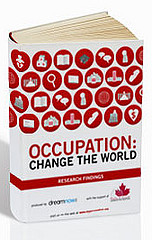|
|
|
Friday, January 8th, 2016
A Friday series exploring Startups and the people who make them go. Read all If the Shoe Fits posts here
 On one of the last days of 2015 I read a great article about the groupthink that pervades Silicon Valley these days. On one of the last days of 2015 I read a great article about the groupthink that pervades Silicon Valley these days.
It reminded me of how teens of every generation display their rebellion against society through their choice of clothes, while simultaneously making sure they “fit in” with their peers.
This is most easily seen in a subgroup like the goths, whose black clothing and makeup sets them apart from other teens, but within which a rigid dress code prevails.
Unlike the Silicon Valley I knew in the 1980s and 90s, today’s Silicon Valley is far more homogenized and undiversified, with little perspective on the “real” world.
The result is that it’s far less creative and exciting than it once was.
Silicon Valley groupthink is also the force behind what Danielle Morrill, CEO & Cofounder of Mattermark, calls the “tyranny of should.”
But sometimes when I am able to quiet that story down, I catch myself listening because it is just so much easier to have someone else figure out what I should do.
In the first days of this new year I urge you to choose between taking the easy road of groupthink and should or following Sam Altman’s path of most resistance.
“You should ignore what your peers are doing or what your peers or parents think is cool. (…) And that’s the hardest part. We’re all so much more susceptible to that than we think.”
Yes, another ‘should’, but not all ‘shoulds’ are created equal.
As always, it’s your choice.
That’s both life’s greatest joy and its greatest fear.
Image credit: HikingArtist
Posted in If the Shoe Fits | No Comments »
Tuesday, November 17th, 2015

I’ve been writing a lot about Silicon Valley culture and, since I don’t live there any more, I usually cite/link to articles from those deep in the tech world who do or who write me directly.
Yesterday a question came in on my Quora feed that asked about the differences working in SV vs. the rest of the country.
If you ever wondered if media descriptions and commentary were hype, propaganda, sour grapes, ignorance or a combination thereof, then you really should take time to read the responses, especially Ken Miyamoto’s.
Miyamoto is a non-tech guy who, at the decrepit age of 39, moved to SV and ended up working for “one of the the most badass and innovative tech startups.”
We have this culture of brilliant kids that have a power that they can implement from a numbers perspective, but often (not always) fail miserably at implementing from personality perspective, yes, but even more so from a social perspective within the workplace and anything involved with that. (…)
There’s a clear disconnect, socially. I don’t know if it’s the generation. I don’t know if it’s the inability to balance responsibility of power and position or ego or what have you. But there’s clearly a disconnect. (…)
The SV is an environment that is overly self-serving, self-rewarding, with little to no practiced responsibility of the social aspect of “the game.”
Beyond that, the SV proved too often be an overly analytical and knee jerk reactionary culture. Here you have young kids thrust into powerful (big or small) positions and, well, they act like young kids.
So to me, the Silicon Valley is a perfect storm of brilliance, power, new culture, money, money, money, and utter lack of social responsibility at times. (…)
That’s the major difference. Going from student to “rock star” so quickly. It leads to ego, blindness, paralysis of analysis, etc. And that culture is ever-spreading with Venture Capitalists young and old ready and willing to profit from it.
Too many of the tech crowd have lost touch with the rest of society, don’t possess the skills to re-enter it and don’t see this as a problem, but the long-term result of losing touch with humanity is to eventually lose one’s own humanity.
(Funny how one’s mind works. I’m not sure why, but writing this reminded me of Isaac Asmiov’s Foundation series. In short, the series tells the story of mathematician Hari Seldon, who spends his life developing a branch of mathematics known as psychohistory, a concept of mathematical sociology. It is disrupted by an outsider known as the Mule, who was not foreseen in Seldon’s plan, so there is no predicted way of defeating him. Although I can’t connect it directly to the current love of data analytics, I’m sure it does and highly recommend it to you.)
Flickr image credit: kristy
Posted in Culture, Ducks In A Row, Entrepreneurs | No Comments »
Tuesday, March 18th, 2014

I find it amusing how frequently I read something that is presented as totally new when, in fact, it was done decade(s) previously.
In this case, it was the agreement not to poach each others engineers, supposedly masterminded by Steve Jobs.
Just how far Silicon Valley will go to remove such risks is at the heart of a class-action lawsuit that accuses industry executives of agreeing between 2005 and 2009 not to poach one another’s employees.
The last time I remember this happening was in the late Seventies/early Eighties by the HR organizations in a group of semiconductor firms, including National Semiconductor, AMD and Intel, among others I can’t remember.
The story was broken by a gossipy semiconductor-focused newsletter to which everyone in the Valley subscribed, shared and denied reading. (Sadly, I can’t remember the name, although it was published by an individual who lived near Santa Cruz.)
Word was that being caught reading the newsletter could get you fired.
When the information surfaced it was the EEOC that fined the companies involved.
It was a stupid corporate move then and just as stupid now, but back then the workers affected didn’t do anything; how times have changed.
Flickr image credit: Harold Heindell Tejada
Posted in Ducks In A Row, Hiring | 1 Comment »
Tuesday, December 10th, 2013

What’s wrong with our so-called leaders?
I finally figured it out.
They live in an alternate reality.
Not all of them, but too many.
And I don’t have to go to Washington (DC) to see them in action.
I can stay home in (southwest) Washington (State)—Clark County, to be exact (nowhere near Seattle.)
We have a county commissioner named David Madore who says he doesn’t know how someone can have a “meaningful” life on $50,000 a year.
First you have to understand Clark County reality.
According to the American FactFinder, a report from the U.S. Census Bureau, data from 2007-2011 indicates the median earning for a single worker in Clark County is $32,337.
Scott Bailey, regional labor economist for the Washington state Employment Security Department, says if you take out all of the seasonal workers from that number, it jumps to about $46,000 or $47,000. The median for men being $51,502 per year, and $40,023 per year for women.
Bailey says more than half the individuals in the county make less than $51,556.
Therefore, substantially more than half of us don’t live meaningful lives.
(New York City, at a median $50,895, is slightly lower, but with a far higher number of peole whose lives aren’t meaningful and those poor folks don’t even have someone to tell them.)
Obviously, Madore lives in an alternate reality.
As do most politicians, corporate chieftains, a good deal of Silicon Valley, Wall Street and others.
Flickr image credit: Jim Champion
Posted in Compensation, Ducks In A Row | No Comments »
Thursday, August 30th, 2012
 As you might imagine, I do a lot of reading about innovation, new products and startups. As you might imagine, I do a lot of reading about innovation, new products and startups.
I have to say that too many are mind-numbingly boring and irrelevant when considered in the long-term—or even the shorter-term.
Whether it’s the (supposedly) hottest in Silicon Valley or Silicon Alley (AKA NYC) how many do you think will matter three or four years from now, let alone in a decade or more?
Many of them sport pedigrees from Tech Stars, Founders Fund, 500 Startups and Y Combinator, which only goes to show that, as with education, graduating from a top-ranked institution doesn’t assure meaningful success. (Be sure to read the comments and you’ll see my disdain is shared by many.)
Now compare them with the startups incubated, nurtured and seeded by Rock Health and Fledge.
Rock Health looks for “Big ideas executed by smart and driven entrepreneurs, to really move the needle in healthcare. Ideas should be addressing large problems in the system, with a business model that is sustainable and scalable.”
Fledge looks for “…companies looking to address the needs of increasingly health, environment and sustainability-conscious consumers in a variety of ways.”
Granted the ideas on Fledge are hyper-local and may not be world-changing at first glance, but if locally applicable iterations spread across the globe then world-changing they would be.
I’m also fully aware that many of the startups I shrug off will make money and be acquired, but it’s doubtful they will make history—even as a footnote.
If you plan/want to found a company why not look for a real need as opposed to a faux one and develop a product or service to address it; the same thing applies when choosing a place to work.
That’s how you change the world.
And just for fun take a look at products you couldn’t live without—from penicillin to Post-its to pacemakers—that all came about because of mistakes, accidents and carelessness that didn’t go unnoticed.
SUBMIT YOUR STORY
Be the Thursday feature – Entrepreneurs: [your company name]
Share the story of your startup today.
Send it along with your contact information and I’ll be in touch.
Questions? Email or call me at 360.335.8054 Pacific time.
Flickr image credit: cambodia4kidsorg
Posted in Entrepreneurs, Innovation | No Comments »
Friday, July 31st, 2009
I lived more than 25 years in and around Silicon Valley. There have been many books written about the area, people and happenings (one of my all time favorites is The Nudist On The Nightshift), with many focused on those who start companies—the famous and infamous Silicon Valley entrepreneurs.
Contrary to much of what you may read in the media none of it is dead; not the VCs, who are raising new funds, or the angels, who invest their own money, and certainly not the entrepreneurs.
Nor are the folks who write about them; some write from the halls of academia, some from the heights of punditship and a few who have actually been there/done that.
One such is Sramana Mitra, a tech entrepreneur who founded three companies, consults with Silicon Valley VCs, writes a column for Forbes and has a MS in electrical engineering and computer science from MIT.
 Bootstrapping: Weapon of Mass Reconstruction is the second book in her Entrepreneur’s Journeys series and it’s a great read. Bootstrapping: Weapon of Mass Reconstruction is the second book in her Entrepreneur’s Journeys series and it’s a great read.
As opposed to a series of lessons to be taught, the book is a series of interviews with entrepreneurs highlighting their fascinating histories, the different paths they took and the difficulties they overcame.
It’s about the need for solid management skill—a book about implementers with vision as opposed to visionaries who depend on others to make it happen.
What you learn from them is up to you, but whether you plan to start a business or not you would have to work very hard not to benefit from their experiences.
The book’s focus is on companies that started and progressed without venture investment. Mitra does an excellent job of pointing out that even without IPOs, M&A and VCs throwing money like beads at Mardi Gras starting a company in your garage with a few friends is not only a solid approach—but a better one.
“If the next Google is to emerge and bring with it thousands of new jobs, it must first start over some kitchen table where not only hope but opportunity is readily available. Where entrepreneurs not only start businesses at a higher rate, but also survive and thrive at a higher rate.”
She points that many businesses fail for lack of funding, but if you don’t look for funding that roadblock ceases to exist.
“Through much discussion, writing, and brainstorming on each topic, I arrived at one core thesis: Not just entrepreneurship, but bootstrapped entrepreneurship is the true weapon of mass reconstruction.”
Having lived through the dot com bubble I know that this is true. Too much available investment makes trust fund babies of companies that need to grow up hungry, tough and scrappy.
Image credit: Sramana Mitra
Posted in Business info, Culture, Motivation, Reviews & Recommendations | 1 Comment »
|
 Subscribe to
Subscribe to
MAPping Company Success
About Miki 
Clarify your exec summary, website, etc.
Have a quick question or just want to chat? Feel free to write or call me at 360.335.8054
The 12 Ingredients of a Fillable Req
CheatSheet for InterviewERS
CheatSheet for InterviewEEs™
Give your mind a rest. Here are 4 quick ways to get rid of kinks, break a logjam or juice your creativity!
Creative mousing
Bubblewrap!
Animal innovation
Brain teaser
The latest disaster is here at home; donate to the East Coast recovery efforts now!
Text REDCROSS to 90999 to make a $10 donation or call 00.733.2767. $10 really really does make a difference and you'll never miss it.
And always donate what you can whenever you can
The following accept cash and in-kind donations: Doctors Without Borders, UNICEF, Red Cross, World Food Program, Save the Children
*/
?>About Miki
About KG
Clarify your exec summary, website, marketing collateral, etc.
Have a question or just want to chat @ no cost? Feel free to write
Download useful assistance now.
Entrepreneurs face difficulties that are hard for most people to imagine, let alone understand. You can find anonymous help and connections that do understand at 7 cups of tea.
Crises never end.
$10 really does make a difference and you’ll never miss it,
while $10 a month has exponential power.
Always donate what you can whenever you can.
The following accept cash and in-kind donations:
|
 On one of the last days of 2015 I read a great article about the groupthink that pervades Silicon Valley these days.
On one of the last days of 2015 I read a great article about the groupthink that pervades Silicon Valley these days.






 As you might imagine, I do a lot of reading about innovation, new products and startups.
As you might imagine, I do a lot of reading about innovation, new products and startups.

